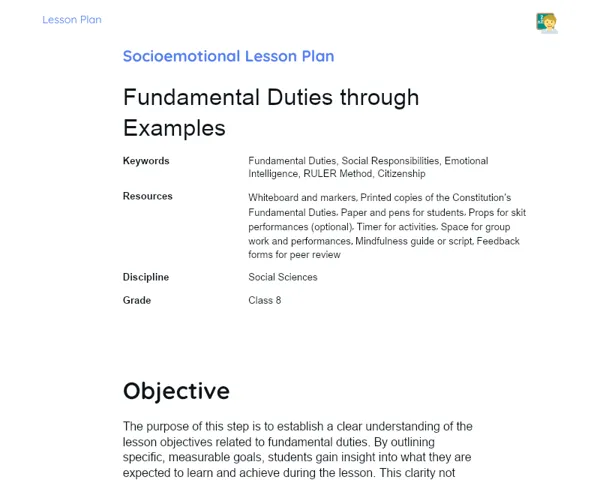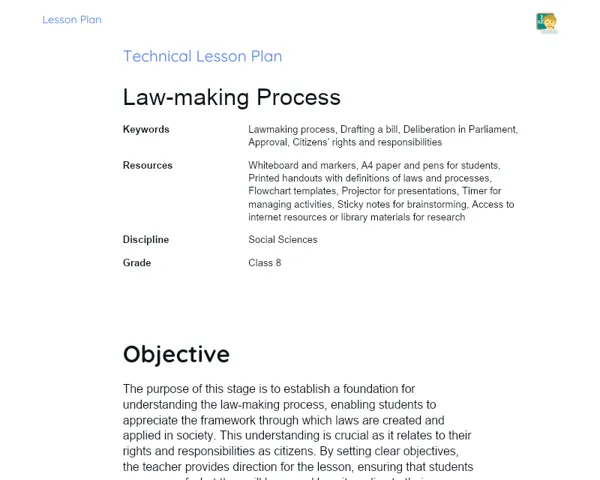Technical Lesson Plan | Analysis of Eclipses Superstitions
| Palavras Chave | Eclipses, Superstitions, Cultural Perspectives, Scientific Explanations, Critical Thinking, Group Discussions, Analytical Skills, Heritage, Natural Phenomena, Job Market, Science Communication |
| Materiais Necessários | Whiteboard and markers, Paper and pens for students, Books about eclipses and cultural superstitions, Access to the internet for research, Visual aids for presentations (posters, charts), Projector (if available) for presentations, Printed handouts of different eclipses and their associated superstitions |
Objective
Duration: (10 - 15 minutes)
The purpose of this stage is to create a solid foundation for students' understanding of superstitions associated with eclipses. By establishing clear objectives, students will know what to expect from the lesson and how it relates to their broader understanding of science and culture. This initial engagement is crucial for sparking interest and curiosity about the topic, setting the stage for deeper exploration and analysis.
Main Objectives:
1. Students will be able to identify and describe various superstitions related to eclipses across different cultures.
2. Students will develop critical thinking skills by analysing these superstitions from both scientific and logical perspectives.
Side Objectives:
- Students will enhance their communication skills by engaging in group discussions about eclipse-related superstitions.
Introduction
Duration: (10 - 15 minutes)
The purpose of this stage is to introduce students to the cultural significance of eclipses and their associated superstitions. By engaging students right from the start with an interesting fact and a group activity, the lesson aims to pique their curiosity and foster a participative environment. This approach will help students connect their personal experiences with the broader cultural contexts that surround the phenomenon of eclipses, setting the stage for a more profound exploration of the topic.
Curiosities and Market Connection
Did you know that some cultures believed that during an eclipse, the sun was being punished, and that they needed to perform certain rituals to bring it back? This reflects a deep connection between societal beliefs and scientific understanding. In today's job market, professionals in fields like science communication, education, and even marketing can benefit from understanding cultural contexts when conveying scientific ideas. This knowledge helps bridge the gap between complex scientific concepts and the public's understanding, which is crucial for effective communication in any scientific field.
Contextualization
In various cultures around the world, eclipses have historically been viewed as powerful and often fearsome events. For instance, during a solar eclipse, many people believed it was a dragon or demon devouring the sun. This lesson will explore these fascinating beliefs and superstitions surrounding eclipses, and help students understand why societies reacted in such dramatic ways. Understanding these superstitions is crucial as it relates to how we perceive natural phenomena today, providing insights into the cultural and scientific evolution of our understanding of the universe.
Initial Activity
Begin the lesson with a brainstorming session. Divide the class into small groups and ask them to share any superstitions or myths they have heard about eclipses in their families or communities. After 5 minutes, invite each group to share one superstition with the class. This will not only engage them but also highlight the diverse cultural perspectives they may have encountered. Following this, the teacher will compile a list of these superstitions on the board, creating a visual reference for the lesson.
Development
Duration: (30 - 35 minutes)
The purpose of this stage is to deepen students' understanding of the concepts surrounding eclipses and their superstitions. Through engaging discussions, critical reflections, and hands-on activities, students will connect cultural beliefs to scientific explanations, fostering both analytical and creative skills.
Topics
1. Definition of eclipses and types: solar and lunar eclipses.
2. Cultural superstitions surrounding eclipses: various beliefs from around the world.
3. The scientific explanation of what happens during an eclipse.
Thoughts on the Subject
Consider how superstitions can shape our understanding of natural events. Why do you think different cultures interpreted eclipses in such diverse ways? What role do science and rational thinking play in how we view these phenomena today?
Mini Challenge
Eclipse Mythbusters!
Students will work in pairs to investigate a specific superstition related to eclipses. They will research its origin, the cultural context, and provide a scientific explanation that debunks or explains the superstition logically. Each pair will then present their findings to the class.
1. Divide students into pairs and assign each pair a different superstition about eclipses.
2. Provide access to books, articles, or the internet for students to research.
3. Instruct students to outline the origin of the superstition, how it reflects cultural beliefs, and a scientific explanation of eclipses.
4. Have each pair prepare a short presentation (3-5 minutes) summarizing their findings.
5. Conduct a class presentation where each pair shares their work, and encourage questions from classmates.
To help students critically assess superstitions, understand cultural perspectives, and apply scientific reasoning.
**Duration: (20 - 25 minutes)
Evaluation Exercises
1. Write a short paragraph explaining one superstition about eclipses and its scientific explanation.
2. Create a visual poster depicting an eclipse and include at least three related superstitions from different cultures.
3. Participate in a group discussion where students share their thoughts on how superstitions can influence modern scientific understanding.
Conclusion
Duration: (15 - 20 minutes)
The purpose of this stage is to consolidate students' learning by allowing them to reflect on their experiences throughout the lesson and appreciate the interplay between superstition and scientific explanation. Engaging in a discussion cultivates a sense of community in the classroom while reinforcing the concepts covered. The summary and closing sections further emphasize the relevance of the topic to their personal development and future careers, ensuring that students recognize the significance of their learning.
Discussion
Facilitate a group discussion by inviting students to share their experiences and insights gained throughout the lesson. Prompt the students with questions like, 'What surprised you about the superstitions related to eclipses?' or 'How do you feel about the contrast between superstition and scientific explanation?'. Encourage them to reflect on any superstitions that were discussed, and to share their thoughts on the impact of these beliefs in their lives and communities. This interaction will enrich their understanding and provide a platform for collaboration and collective learning.
Summary
In this lesson, students explored the fascinating world of eclipses and their associated superstitions across diverse cultures. They learned about different types of eclipses, the reasons behind various superstitions, and how scientific explanations debunk many of these myths. Through engaging activities, students developed their critical thinking skills by analysing the cultural significance of eclipses and how these beliefs have evolved over time. They not only recognized the impact of heritage and tradition on understanding natural phenomena but also established a bridge between science and culture.
Closing
Understanding eclipses and the superstitions surrounding them is not merely an academic exercise; it plays a significant role in shaping future professionals. In various fields such as science communication, education, and cultural studies, having the ability to connect cultural beliefs with scientific reasoning is invaluable. This foundational knowledge prepares students for a career in which they can convey complex scientific concepts in a manner that resonates with the public. By appreciating how cultural perspectives influence the interpretation of scientific phenomena, students will be equipped to address challenges in the real-world job market more effectively.



